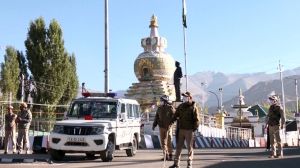Godrej Centre discovers new species of plant
PUNE, DEC 27: The research scientists at Naoroji Godrej Centre for Plant Research (NGCPR), dotting the otherwise parched plains of Satara'...

PUNE, DEC 27: The research scientists at Naoroji Godrej Centre for Plant Research (NGCPR), dotting the otherwise parched plains of Satara’s Khandala taluka has achieved the distinction which would have taken a lifetime for a botanist.
The Royal Botanic Garden, the Kew Garden, has credited the NGCPR with the discovery of a new plant species. Paying homage to founding father of Godrej industry Naoroji Godrej, it was named Brachystelma naorojii.
More vital is the Centre’s contribution in pulling back Frerea indica Dalz, a Lilliputian flowering plant endemic to the Western Ghats from the edge of extinction. Once listed as one of the 12 most endangered plants on the earth by the International Union for Conservation of Nature and Natural Resources, Frerea indica is now being successfully grown here.
Set up seven years ago NGCPR, an unusual activity for a leading corporate house, is now home to about 500 rare and near-extinct plants from across the sub-continent. Instead of applied research the institute hadopted for basic research in plant life from the very outset, Director Vijay Mohan Crishna corporate consultant and NGCPR senior analyst Dilip Oak told The Indian Express. The centre aimed at developing a strong research base for its planned foray in to pharmaceuticals.
However, the Centre’s contribution in helping preserve the time-tested Indian medical traditions has been more important, Oak claimed.Senior scientist at the Centre Dr P Tetali said, “Try seriously, cultivate, multiply and propagate’ is the mantra here. Things are right here in our own backyard. The tuberous plant, Brachystelma naorojii that won international acclaim for the Centre, was brought from the barren hill slopes of a nearby village.”
The miracle happened two years after. The plant flowered. This was a crucial event for a botanist, for in botany flowers identify a plant. Although its genus was identified as Brachystelma, often eaten raw by the locals, Tetali and his team could not match it with anything in the botany books.
Till the Royal Gardens at Kew confirmed it to be a separate plant type, it was thought to be close to a species found around gold fields of Kolar in neighbouring Karnataka. It was certainly a great moment since only five to seven new types of plant are discovered from the Indian subcontinent every year, and Brachystelma naorojii was one of them, Tetali added.
Oak said the fate of the species that forms the base of the traditional Indian medicine has become a matter of concern for the scientists. Besides, conservationists also face the problem of widespread desolation of land. The phenomenon is so alarming that experts claim that the green cover of over 75,000 sq kms area fall victim to `developmental pressures’. The available ways out are either to face the elimination or try seriously to reverse the situation. The NGCPR preferred to take the latter option, Oak revealed.Interestingly, the Centre itself has been the creation of the need to have a green cover for Lawkim village.





- 01
- 02
- 03
- 04
- 05


























